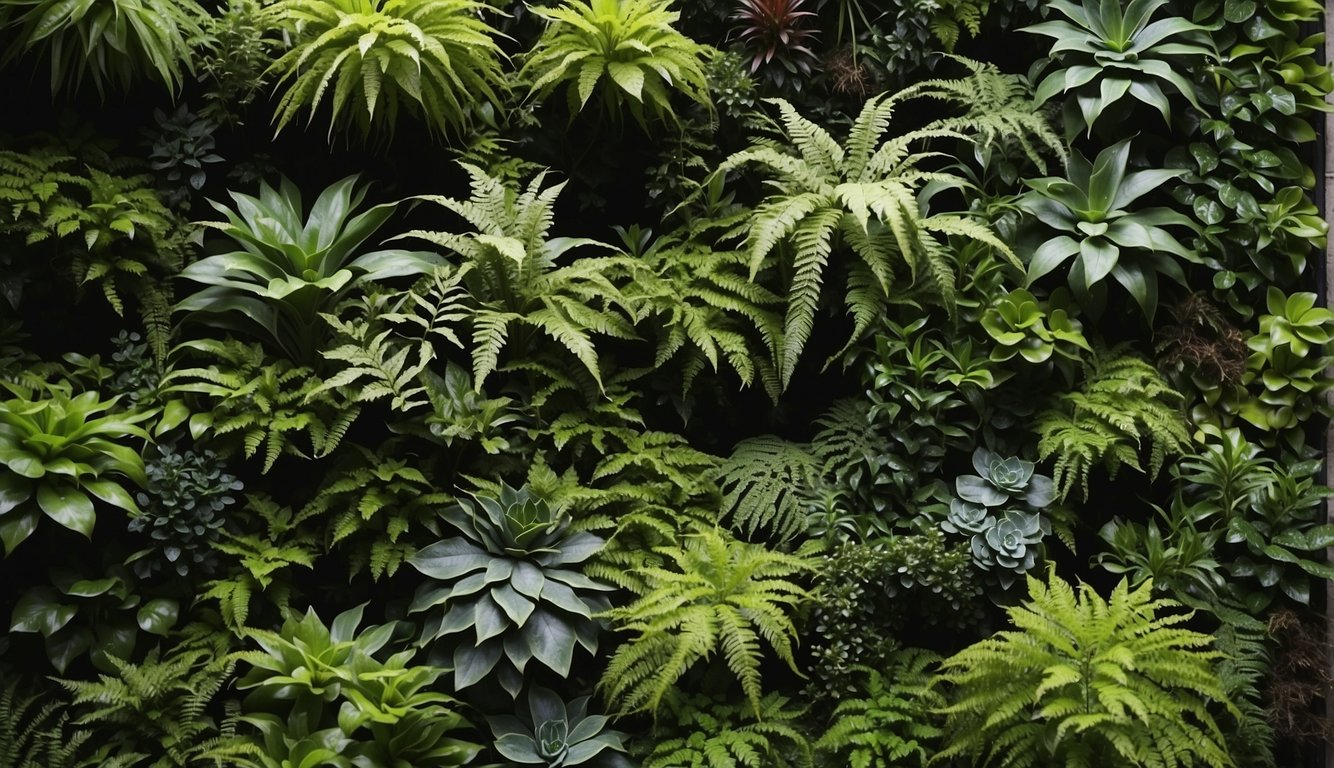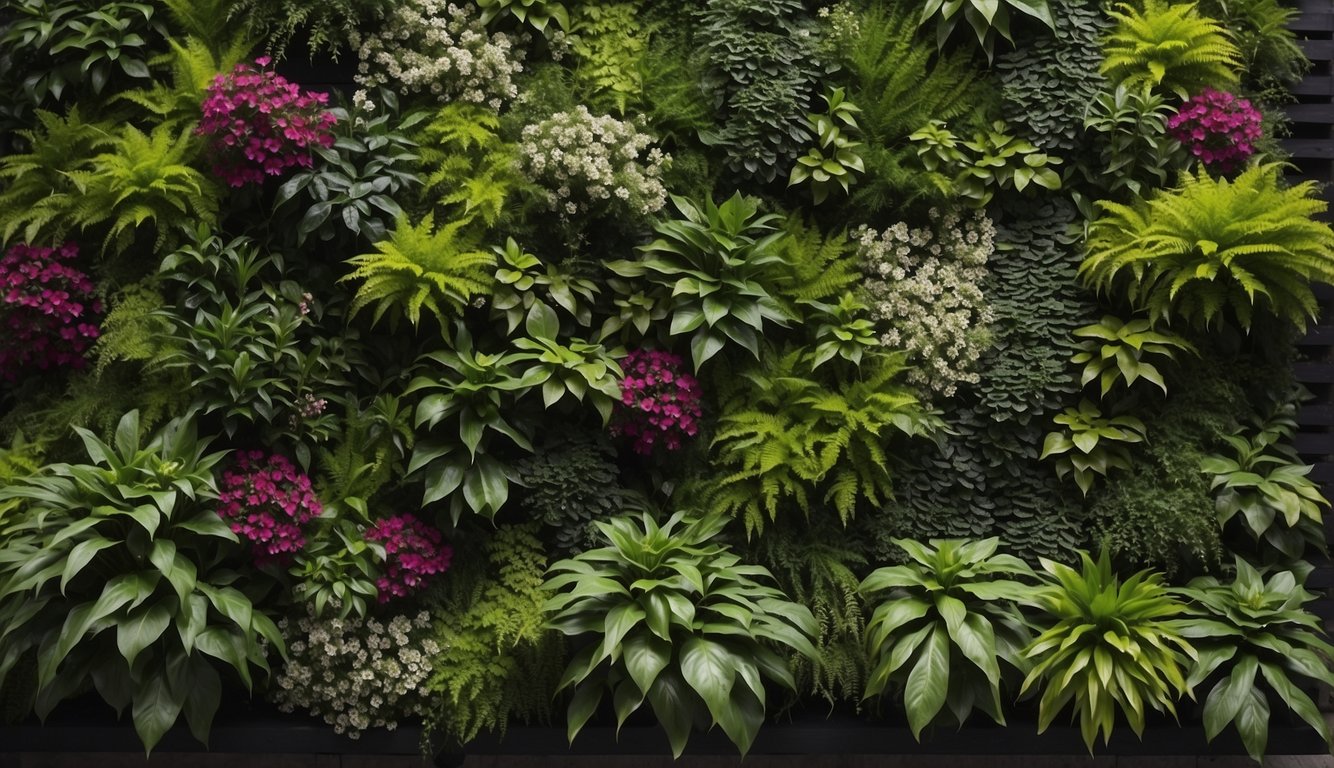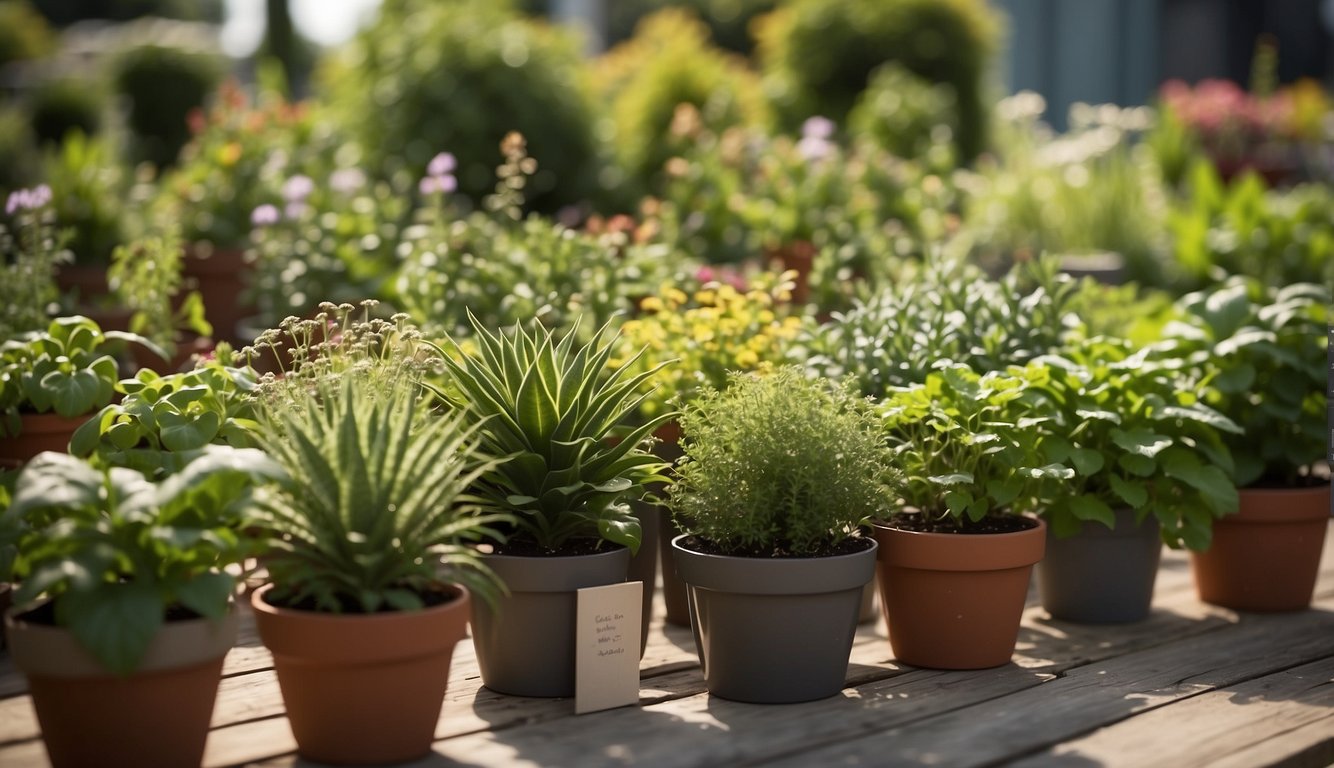Vertical gardens are a fantastic way to bring the beauty of nature into your living space while also maximizing your available space. With the right selection of plants, you can create a vertical garden that’s not only beautiful but also productive. In this article, we’ll discuss the best plants for a vertical garden and how to select them to ensure a thriving and healthy garden.

Understanding the unique requirements of vertical gardens is key to selecting the right plants. Vertical gardens require plants that are lightweight, fast-growing, and don’t require a lot of soil or space. Additionally, the plants should have shallow roots and be able to grow vertically without sprawling. By taking these factors into account, you can select plants that will thrive in your vertical garden and provide you with a beautiful and productive space.
Table of Contents
Key Takeaways
- Vertical gardens require plants that are lightweight, fast-growing, and don’t require a lot of soil or space.
- The best plants for a vertical garden include herbs like basil, parsley, and chives, as well as climbing flowers like morning glories and clematis.
- With the right selection of plants and proper care, you can create a beautiful and productive vertical garden that will thrive in your living space.
Understanding Vertical Gardens
Vertical gardening is a creative solution that turns small spaces into lush, productive areas. In this section, we will cover the basics of vertical gardening, including choosing the right location, types of vertical gardens, and the benefits of vertical gardening.
Basics of Vertical Gardening
Vertical gardening is a method of growing plants upwards using structures like trellises, wall planters, or stacked containers. This technique maximizes greenery in urban environments and adds aesthetic value, while being a practical solution for gardening enthusiasts. Vertical gardens come in many shapes and sizes, and can be tailored to fit any space, from a small balcony to a large living wall.
Choosing the Right Location
When choosing the location for your vertical garden, consider the light conditions. Most plants require sunlight to grow, so make sure your vertical garden receives enough light. If your vertical garden is indoors, consider using grow lights to supplement natural light. Also, make sure your vertical garden is easily accessible for watering and maintenance.
Types of Vertical Gardens
There are many types of vertical gardens, including living walls, green walls, trellises, and wall planters. Living walls and green walls are vertical gardens that are built into the structure of a building. They are often used for aesthetic purposes, and can help reduce energy costs by insulating the building. Trellises are vertical structures that support climbing plants like cucumbers, tomatoes, and beans. Wall planters are containers that are mounted on a wall and can be used to grow a variety of plants.
In conclusion, understanding the basics of vertical gardening, choosing the right location, and selecting the right type of vertical garden are essential for a successful vertical garden. With the right structure and plant selection, a vertical garden can turn any space into a lush, productive garden.
Designing Your Vertical Garden

When it comes to designing a vertical garden, there are a few key elements to consider. In this section, we will discuss how to select suitable plants and create an aesthetic appeal for your vertical garden.
Selecting Suitable Plants
Choosing the right plants for your vertical garden is crucial for its success. Consider the size of your garden, the frame, and the pots you will be using. Climbing plants are a great option for vertical gardens as they can grow upwards and create a unique, eye-catching display.
When selecting plants, consider the type of plant you want to use. Flowers and vegetables can add color and texture to your garden, while ferns and succulents can provide interesting foliage. Consider the amount of light your garden will receive and select plants accordingly.
Creating an Aesthetic Appeal
Creating an aesthetic appeal for your vertical garden is important to make it visually appealing. Consider the overall look you want to achieve and select plants that fit that theme. For example, if you want a garden with a lot of flowers, choose flowering plants that will bloom at different times of the year.
In addition to plant selection, consider the placement of your plants. Grouping plants with similar colors or textures can create a cohesive look. Use different pot sizes and heights to add depth to your garden.
Overall, designing a vertical garden requires careful consideration of plant selection and aesthetics. By selecting suitable plants and creating an eye-catching display, you can create a beautiful and unique garden that will be the envy of your neighbors.
Planting and Maintenance
Planting and maintenance are two critical aspects of vertical gardening. Proper soil and water management, pruning, and care ensure that your plants grow healthy and produce a bountiful harvest. In this section, we will discuss the key factors that you need to keep in mind while planting and maintaining your vertical garden.
Soil and Water Management
The soil and water requirements of plants in vertical gardens are different from those grown in traditional gardens. In vertical gardens, the soil mix should be lightweight and well-draining to prevent waterlogging. A mix of peat moss, vermiculite, and perlite is an excellent choice for vertical gardens. It is important to ensure that the soil mix contains enough nutrients and organic matter to support plant growth.
Watering is a crucial aspect of vertical gardening. The frequency of watering depends on the climate, the type of plants, and the irrigation system used. Overwatering can lead to root rot, while underwatering can cause the plants to wilt and die. A drip irrigation system is an excellent choice for vertical gardens as it delivers water directly to the roots of the plants, preventing water wastage.
Pruning and Care
Pruning is an essential aspect of vertical gardening. It helps to promote healthy growth, increase fruit and flower production, and prevent the spread of diseases. Regular pruning also helps to control the size and shape of the plants, making them more manageable.
Maintenance is critical to the success of your vertical garden. Regular inspections help to identify pests, diseases, and nutrient deficiencies. It is essential to keep an eye on the plants and address any issues promptly. Fertilizing is also important to ensure that the plants have enough nutrients to grow healthy.
In summary, proper soil and water management, pruning, and care are essential for the success of your vertical garden. With the right techniques, you can grow healthy plants that produce a bountiful harvest.
Growing Edibles Vertically
Vertical gardens are a great way to grow edibles in a small space. By carefully selecting the right plants for your vertical garden, you can create a thriving, bountiful oasis that provides fresh produce and enhances your overall well-being. Here are some of the best plants for growing edibles vertically.
Herbs and Leafy Greens
Herbs and leafy greens are some of the easiest plants to grow in a vertical garden. They are also some of the most versatile, as they can be used in a wide variety of dishes.
- Lettuce: Lettuce is a great plant for vertical gardens. It grows quickly and can be harvested multiple times throughout the growing season.
- Basil: Basil is a popular herb for cooking and is easy to grow in a vertical garden. It is also a great companion plant for tomatoes.
- Parsley: Parsley is another herb that is easy to grow in a vertical garden. It is also a great source of vitamin C.
- Spinach: Spinach is a leafy green that is packed with nutrients. It is also easy to grow in a vertical garden.
- Thyme: Thyme is a fragrant herb that is great for cooking. It is also a natural insect repellent.
- Oregano: Oregano is another fragrant herb that is great for cooking. It is also a natural insect repellent.
- Chives: Chives are a member of the onion family and are great for adding flavor to dishes.
Fruits and Vegetables
Fruits and vegetables are a little more challenging to grow in a vertical garden, but they are still possible. Here are some of the best plants for growing fruits and vegetables vertically.
- Tomatoes: Tomatoes are one of the most popular plants for vertical gardens. They are easy to grow and come in a wide variety of sizes and colors.
- Peppers: Peppers are another popular plant for vertical gardens. They come in a wide variety of colors and can be used in a variety of dishes.
- Beans: Beans are a great plant for vertical gardens. They are easy to grow and come in a wide variety of colors and sizes.
- Peas: Peas are a cool weather crop that can be grown in a vertical garden. They are also a great source of protein.
- Cucumbers: Cucumbers are a little more challenging to grow in a vertical garden, but they are still possible. They are great for salads and sandwiches.
- Strawberries: Strawberries are a great plant for vertical gardens. They are easy to grow and come in a wide variety of sizes and colors.
- Squash: Squash is a little more challenging to grow in a vertical garden, but it is still possible. It comes in a wide variety of sizes and colors.
When selecting plants for your vertical garden, it is important to consider their growing habits. Some plants, like climbing roses and morning glories, are great climbers and will do well in a vertical garden. Other plants, like herbs and leafy greens, are great for hanging baskets or small pots. By selecting the right plants for your vertical garden, you can create a beautiful and productive space that will provide you with fresh produce all season long.
Conclusion

In conclusion, plant selection is a crucial factor to consider when creating a vertical garden. By choosing the appropriate plant species, we can ensure the optimal growth, health, and aesthetics of our garden.
We have learned that factors such as sunlight requirements, root structure, growth habits, space constraints, watering needs, soil, and nutrient requirements should be taken into consideration when selecting plants for our vertical garden. We can use tools such as online plant databases, gardening books, and expert advice to help us make informed decisions.
When it comes to space-saving, vertical gardening is an innovative approach that offers several advantages. By utilizing vertical surfaces, we can maximize our available space and create a beautiful and productive garden in even the smallest of areas.
Whether we are gardening indoors or outdoors, at home or in a public space, vertical gardening offers a practical solution for harnessing nature and enhancing our environment. With the right plant selection and care, we can create a thriving vertical garden that is both sustainable and aesthetically pleasing.
In summary, we encourage you to explore the world of vertical gardening and experiment with different plant species to create your own unique and beautiful garden.
Frequently Asked Questions

Which perennial plants thrive in vertical gardens?
Perennial plants are a great option for vertical gardens as they tend to have a longer lifespan than annuals. Some popular perennial plants that thrive in vertical gardens include ferns, hostas, and ivy. These plants are low maintenance and can add a lush, green look to your garden.
What are the top edible plants suitable for vertical gardens?
Vertical gardens are a great way to grow your own fresh produce, even if you don’t have a lot of space. Some popular edible plants that are suitable for vertical gardens include strawberries, tomatoes, and herbs like basil, thyme, and mint. These plants are easy to grow and can be harvested regularly.
Can you recommend flowering plants that are ideal for vertical gardens?
Flowering plants can add a pop of color and beauty to your vertical garden. Some popular flowering plants that are ideal for vertical gardens include petunias, pansies, and marigolds. These plants are low maintenance and can thrive in a variety of conditions.
Which vegetables are most suited for cultivation in vertical gardens?
Vertical gardens are a great way to grow your own fresh vegetables. Some popular vegetables that are well-suited for vertical gardens include cucumbers, beans, and peas. These plants can be trained to grow up trellises or other vertical structures, making the most of limited space.
How do I choose plants for a vertical garden in full sun conditions?
When choosing plants for a vertical garden in full sun conditions, it’s important to select plants that can tolerate high levels of heat and sunlight. Some good options include succulents, cacti, and herbs like rosemary and thyme. These plants are adapted to dry, sunny conditions and can thrive in a vertical garden.
What are the best options for plants in a shaded vertical garden?
If your vertical garden is in a shaded area, it’s important to select plants that can thrive in low-light conditions. Some good options include ferns, mosses, and ivy. These plants can add a lush, green look to your garden and can thrive in shaded conditions.


